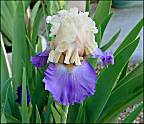
Iris Culture In Tucson
Soil
Amendments: A soil amendment improves the soil. It is
different than a fertilizer in that it improves or maintains
the soil's texture, water retention, and drainage. Soil
amendments can be broken down into two categories: organic
and inorganic materials.
Organic Materials: long term effect of reducing alkalinity
of native soil.
1. Compost: Builds good soil structure, is a source of many
slow release nutrients. Use 25% to 50% of total soil volume
depending on condition of soil being amended. You can't
use too much!
2. Manures: They are hot! They must be composted before
use or mixed into the soil 4 weeks prior to planting. Manures
should never come in contact with the rhizomes! It is recommended
that manure never be used in the top 4" of soil.
3. Peat Moss: Relatively expensive to use on a large scale.
Use 25% to 50% of total soil volume.
4. Shredded Wood By-products: Also known as mulch/sawdust.
These products must be used with the addition of some nitrogen
unless they are already fortified by the manufacturer. Use
25% to 50% of total soil volume.
Inorganic materials: Used for specific purposes, i.e.. Water
retention in sandy soils.
1. Physical Amendments: Perlite and pumice are inert materials
that improve the texture of clay soils and because they
are porous, they absorb water. They last longer than organic
materials, but provide no plant nutrients and are expensive.
Vermiculite and expanded mica can absorb water, nutrients,
and provide some potassium and magnesium. It does not last
as long in the soil as perlite and pumice.
2. Chemical Amendments:
a.) Gypsum: calcium sulfate is used to rid soils of excess
sodium allowing the soil to absorb water more readily. It
also supplies some sulfur. Use 20-30 lbs. Per 100 ft and
apply 4" of water.
b.) Sulfur: is used to reduce the alkalinity of Tucson soils.
Use 5 lbs. Per 100 ft.
c.) Lime: is not used in the native soils of Tucson.
| Fertilizers | |
| Organic | Chemicals |
| Alfalfa Meal or Pellets | Ammonium Phosphate 16-20-0 |
| Bloodmeal | Ammonium Sulfate 21-0-0 |
| Bonemeal | Super Phosphate |
| Cottonseed Meal | Triple Superphosphate 0-45-0 |
| Green
Manuring (growing cover Best Phosphate 11-52-0 Crops to be turned over) |
Timed Fertilizers (i.e., Osmocote) |
| Horn and Hoof Meal |
ALWAYS follow directions provided by the manufacturer of fertilizers for best results.
| Soil Recipe |
This recipe is for most types of Bearded Iris, Spurias, Arils, and Arilbred irises.
This
recipe is based on an iris bed of the following size:
100 ft2 (10'x10')
Dug 18 " deep (5.5 yd.3)
Dig out, screen to remove rocks, and save native soil. Fill hole with water and allow it to drain. If it doesn't drain, keep digging until it does, or consider building a raised iris bed. Drainage is very important to the health of your plants.
Add to the native soil the following ingredients:
1.5
cubic yards of compost
8 cubic feet of medium vermiculite
25 lbs. Gypsum
5 lbs. Sulfur
100 lbs. Alfalfa Meal
100 lbs. Cottonseed Meal
¾ lbs. Ammonium Sulfate
¾ lbs. Triple Superphosphate
